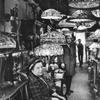American Scenery: Different Views in Hudson River School Painting on view at Reading Public Museum
- READING, Pennsylvania
- /
- April 06, 2011

An exhibition of 116 Hudson River School paintings drawn from a remarkable and comprehensive private collection will be on view at the Reading Public Museum through June 5, 2011. American Scenery: Different Views in Hudson River School Painting features outstanding works by key figures in the movement including Thomas Cole, Frederic E. Church, Jasper Francis Cropsey, Asher B. Durand, John Frederick Kensett, John William Casilear, Benjamin Champney, William Trost Richards and Alfred Bricher, as well as women members Laura Woodward and Edith Wilkinson Cook, and other accomplished but lesser known artists.

The collector’s passionate observations about each artists’ diverse approach and skillful rendering of natural effects as light, weather, time of day, and season was the driving force to assemble this special collection. The exhibition was organized by the Westmoreland Museum of American Art in Greensburg, Pennsylvania. Information about educational programming in conjunction with the exhibition will be posted on the Museum’s Web site, www.readingpublicmuseum.org.
Considered by many to be the first truly American school of painting, the Hudson River School flourished between 1825 and 1875 and celebrated the vast natural resources of the American landscape just prior to the industrialization that forever changed that landscape. The movement was embraced by three generations of artists who shared common principles which united them as a school despite their individual differences in style. Primary among these was a belief in natural religion, a deep admiration for the magnificence of the land, and a keen interest in the direct observation of nature. Most importantly was an awareness of the fresh, untamed American scenery as reflective of the optimism and independence of our character as a young nation. The style was not geographically confined to the Hudson River region, however, and Thomas Cole’s Sunset at the Arno (1837), paired with Frederic Church’s Ruins at Baalbek (1868) were selected to compare approaches to the landscape outside of the region.

The exhibition investigates the practice of how Hudson River School artists created pairs, series, and groupings of landscape paintings that are thematically related and intended to be viewed together. Visitors are encouraged to compare and contrast how different generations of artists interpreted the majestic American landscape. Influenced by the ever-changing landscape around them, artists and works in the exhibition are organized according to nine themes, of which Times of Day; Weather Conditions, Atmosphere, and Mood; Man’s Impact on Nature; The Machine in the Garden, are included.
The purpose of the exhibition is to revive the public’s ability to appreciate nineteenth-century American landscape painting and to provide insight into the iconographical base that gives it greater meaning in order to more fully comprehend its achievement. This will also bring about a deeper understanding of the profound reaction our forefathers experienced when encountering the extraordinary natural bounty of America and how it was attuned to the buoyant hopes they held for their lives in this new nation.
The exhibition is accompanied by a fully illustrated catalogue published by Columbia University Press and includes essays, a complete checklist and descriptions of each pairing and grouping of paintings.
Reading Public Museum • 500 Museum Road • Reading, PA 19611-1425 • 610-371-5850
500 Museum Road
Reading, Pennsylvania
museum@readingpublicmuseum.org
610-371-5850
http://www.readingpublicmuseum.org








100x100_c.jpg)






